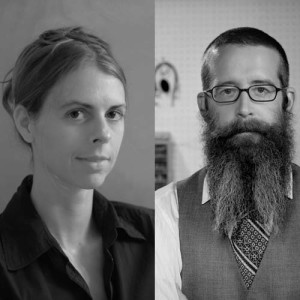 Alex Braidwood works with sound. He is interested in the idea that negotiating noise is a condition of living in a populated environment. His work is not concerned with canceling or eliminating noise. Instead, he investigates methods for transforming the relationship between people and the noise that surrounds them. He is a designer, media artist and design educator who maintains a practice centered around a process of play, experimentation and research through making. Alex’s current work explores methods for transforming the relationship between people and the noise in their environment. Currently, Alex is Assistant Professor of Graphic Design and a faculty member of the Human Computer Interaction Graduate Program at Iowa State University.
Alex Braidwood works with sound. He is interested in the idea that negotiating noise is a condition of living in a populated environment. His work is not concerned with canceling or eliminating noise. Instead, he investigates methods for transforming the relationship between people and the noise that surrounds them. He is a designer, media artist and design educator who maintains a practice centered around a process of play, experimentation and research through making. Alex’s current work explores methods for transforming the relationship between people and the noise in their environment. Currently, Alex is Assistant Professor of Graphic Design and a faculty member of the Human Computer Interaction Graduate Program at Iowa State University.
Meredith Lynn Morrison works with paint. Her work collapses the micro and macro into a flatness of image that is independent of scale. Her formal language is predominantly rooted in land-based themes, supported by a belief that the fundamental, existential truths to life exist uninterrupted in the natural world, all we have to do is learn from them. She is a maker and educator who earned her MFA from Cranbrook Academy of Art. She engages in a practice that is both contemporary and cross-disciplinary, largely focused on the intersection of art and design. She has shown and performed her work across the United States, both independently and in collaboration. Meredith also serves as Assistant Professor of Graphic Design at Drake University.
Braidwood and Morrison will be showing two pieces at SoundWalk 2013.
Alert Fatigue is an installation that explores this complex relationship to the cacophony of alerts and alarms that many experience. We are surrounded by so many things that sonically are vying for our attention that it can become overwhelming unless we modify our behavior around them. In our normal life, we are surrounded by objects and devices that chirp, buzz, ring, wail and beep in order to get our attention. Pretty soon, our soundscape is filled with so many alerts, alarms and notification that we can barely keep track of them. In some cases, as has been reported in a variety of health care facilities, too many alerts renders one numb to the affects of the sound. It becomes ignorable through familiarity and thus looses it’s affect as a notification system. The project consists of a space where custom made, circuit-bent smoke detectors have been installed on the walls and ceilings, much the same as they would be in a home or place of business. The participants are asked to wear modified hearing protection headphones to interact within the space. The circuit-bent smoke detectors create the noise composition while the modified headphones transform it for the individual listener into a personal performance within a public space.
NoiseScape: Yellowstone is an installation of multiple panels with each panel containing a speaker embedded in the surface as an independent sound sourced is which is battery powered. From a series of on-site investigations in the park, each panel is created from visual and auditory research / gathering done at unique locations. The panels progress from one end to the other, creating a sound and visual scape unique to the park, highlighting the (sonic and visual) poetry that results. Noise, as we understand it is not isolated to the man-made. Noise exists everywhere in the natural world, and is specifically noticeable in Yellowstone National Park. The auditory landscape in the park is unique to the geology that shapes it. As is the visual terrain.